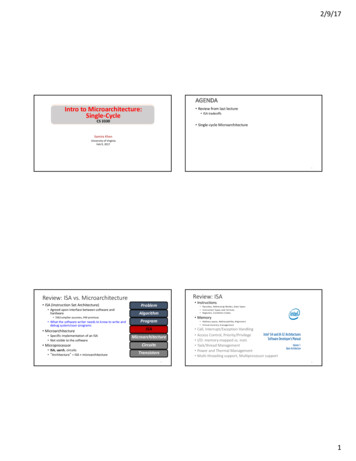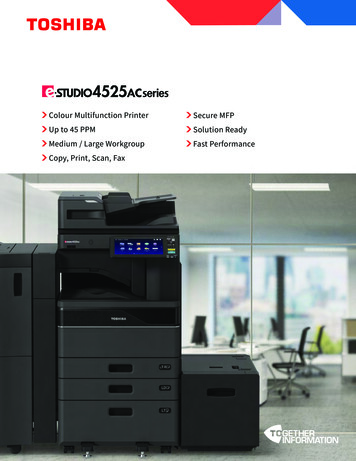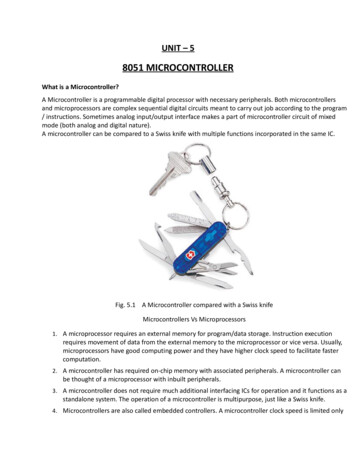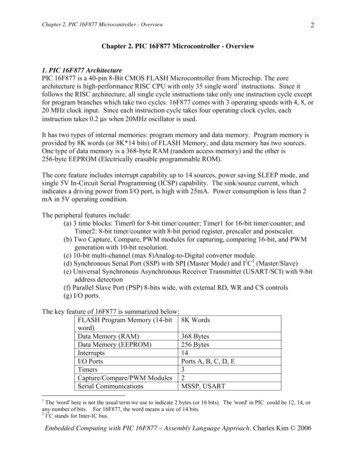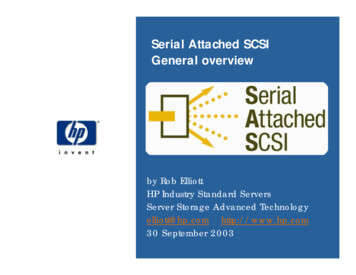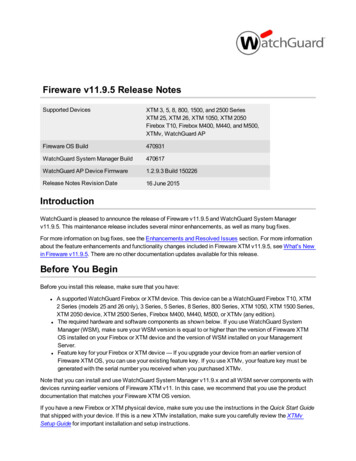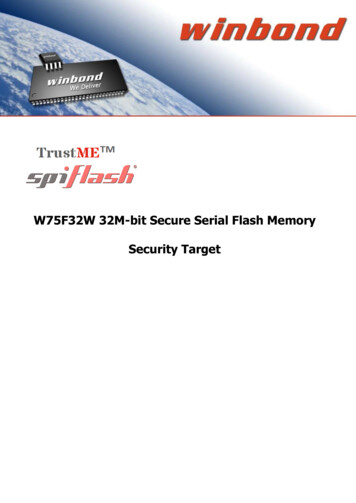
Transcription
W75F32W 32M-bit Secure Serial Flash MemorySecurity Target
Table of Contents1SECURITY TARGET INTRODUCTION . 51.11.21.3SECURITY TARGET REFERENCE. 5TOE REFERENCE . 5TOE OVERVIEW. 61.4TOE DESCRIPTION . 61.51.6TOE OPERATING MODES . 9TOE LIFE-CYCLE . 91.3.11.3.21.3.3TOE Type . 6TOE Intended Usage . 6Non-TOE Hardware/Software/Firmware . 61.4.11.4.2Physical Scope . 6Logical Scope . 82CONFORMANCE CLAIM . 102.12.22.33CC CONFORMANCE CLAIM .10PP CLAIM .10PACKAGE CLAIM .10SECURITY PROBLEM DEFINITION . 113.1ASSETS .113.23.33.4USERS/SUBJECTS .12THREATS .12ORGANIZATIONAL SECURITY POLICIES .133.1.13.1.2TSF data.11User Data .113.4.1Assumptions .134SECURITY OBJECTIVES . 144.14.24.3SECURITY OBJECTIVES FOR THE TOE .14SECURITY OBJECTIVES FOR THE OPERATIONAL ENVIRONMENT .15SECURITY OBJECTIVES RATIONALE.164.3.14.3.24.3.35Threats .16Assumptions .16SPD and Security Objectives .16EXTENDED REQUIREMENTS . 195.1EXTENDED FAMILY FMT LIM – LIMITED CAPABILITIES AND AVAILABILITY .195.2EXTENDED FAMILY FDP SDC - STORED DATA CONFIDENTIALITY.215.1.15.1.2Description .19Extended Components.205.2.15.2.2Description .21Extended Components.226SECURITY REQUIREMENTS . 236.1SECURITY FUNCTIONAL REQUIREMENTS .236.1.16.1.2Revision BMalfunctions .23Abuse of Functionality .24Publication Release date: Apr 2017Page 2
6.1.36.1.46.1.56.1.6Physical Manipulation and Probing.25Leakage .26Secure Data Exchange .26Protection of the Binding Key .286.2.1Refinements of the TOE Assurance Requirements .286.3.16.3.26.3.36.3.46.3.56.3.6Objectives .29Rationale Tables of Security Objectives and SFRs .30Dependencies .31Rationale for the Security Assurance Requirements .33ALC DVS.2 Sufficiency of Security Measures .33AVA VAN.5 Advanced Methodical Vulnerability Analysis .346.2SECURITY ASSURANCE REQUIREMENTS.286.3SECURITY REQUIREMENTS RATIONALE .297TOE SUMMARY SPECIFICATION . 357.17.2TOE SUMMARY SPECIFICATION .35SFRS AND TSS.387.2.1Association tables of SFRs and TSS .388REVISIONS . 399ANNEX . 409.19.29.3Revision BGLOSSARY .40ABBREVIATIONS .40REFERENCES .40Publication Release date: Apr 2017Page 3
Table of FiguresFigure 1: TOE Architecture . 7Table of eTableTableTableTableTableTable1: TOE Identification . 52: Operating Modes . 93: TOE Life-cycle . 94: Threats and Security Objectives – Coverage .165: Security Objectives and Threats – Coverage .176: Security Objectives and OSPs – Coverage .177: Assumptions and Security Objectives for the Operational Environment – Coverage .178: Security Objectives for the Operational Environment and Assumptions – Coverage .189: Security Objectives and SFRs – Coverage .3010: SFRs and Security Objectives .3011: SFRs Dependencies .3112: SARs Dependencies .3213: SFRs and TSS – Coverage .3814: TSS and SFRs – Coverage .3815: History of Modifications .39Revision BPublication Release date: Apr 2017Page 4
1Security Target IntroductionThis introductory chapter contains the following sections: Security Target ReferenceTOE ReferenceTOE OverviewTOE DescriptionTOE Operating ModesTOE Life-cycleThis Security Target is based on the Security IC Platform Protection Profile withAugmentation Packages [5]. However, the Security Target does not include the RandomGeneration and the IC Identification security objectives. The corresponding assumptions ofthe Protection Profile are not used; they are replaced by other assumptions.On the other hand, the Security Target includes additional elements not required by theProtection Profile [5]. Those security elements (threats, security objectives, SFR) areclearly identified in each chapter of this document.1.1 Security Target Reference Title: Security Target Lite of W75F32W 32M-bit Secure Serial Flash MemoryVersion: BAuthors: Winbond Technology Ltd.Evaluator: ApplusCertified by: CCN Organismo de Certificacion1.2 TOE ReferenceThe Target of Evaluation (TOE) is identified as below:Table 1: TOE IdentificationCommercial NameSecure Serial Flash MemoryProduct NameW75F32WVersionDReference DesignG1GuidanceRevision BOperational User Guidance [17]Preparative Procedure [18]Datasheet [6]Publication Release date: Apr 2017Page 5
1.3 TOE Overview1.3.1 TOE TypeThe Target of Evaluation is a Flash Memory IC.1.3.2 TOE Intended UsageThe TOE is intended to be embedded into highly critical hardware devices, such as smartcards, secure elements, USB tokens, and secure micro SDs. These devices will embedsecure applications, such as financial, telecommunication, and identity (e-Government)applications, and will be working in a hostile environment. In particular, the TOE isdedicated to the secure storage of the code and data of critical applications.The security needs for the TOE include: Maintaining the integrity of the content of the memory and the confidentiality of thecontent of protected memory areas as required by critical hardware products (e.g.,Security IC) that the Flash Memory is built for.Providing a secure communication with the Host device, which will embed the TOE ina secure hardware product (e.g., Security IC).1.3.3 Non-TOE Hardware/Software/FirmwareFor the present Security Target, the TOE is a pure-storage hardware device.The TOE does not comprise: The Host device that will embed the TOE and will be needed to run the TOE in orderto stimulate the TOE Security Functionality (TSF).The Serial Peripheral Interface (SPI) Bus for communication between the Host deviceand the TOE.The Security Target assumes that all components (hardware or software) of the Hostdevice are appropriately protected in the TOE security environment.1.4 TOE Description1.4.1 Physical ScopeThe TOE comprises: All security functionality necessary to ensure the secure execution of the FlashMemory.Guidance for the secure usage of the TOE: Operational User Guidance [17] ,Preparative Procedure [18] and Datasheet [6].Revision BPublication Release date: Apr 2017Page 6
1.4.1.1 TOE Physical CharacteristicsThe TOE physical characteristics are described herein. Capacity: 32M-bit/4M-bytePerformance:oooo Efficiency:oo 16-byte burst readData Integrity CheckAllows secure execution in place (S-XIP) operationOperating conditions:ooo 50MHz Standard/Quad/Octal SPI clocks28MB/S continuous encrypted and authenticated data transfer rateMore than 100,000 erase/program cyclesMore than 20-year data retentionSingle 1.65 to 1.95V supply2mA active current, 1μA Power-down (typ.)-40 C to 85 C operating range4KB-block ArchitectureUniform Block Erase (4K-bytes)Program 1 to 16 byte in a single commandErase/Program Suspend & Resume1.4.1.2 TOE ArchitectureThe architecture of the Flash Memory is described in Figure 1. The TOE is delimited by theRed box.Figure 1: TOE ArchitectureRevision BPublication Release date: Apr 2017Page 7
The TOE consists of the following hardware components: Auxiliary array contains the flash specific data: the Binding key (and its digest value),and the failure and session counters.Flash array stores the user data (i.e., the mass data including executable codes) andtranslates SPI commands into Flash operations.SFF (Secure Flash Front-end) implements the encrypted and authenticated interfacefor Flash operation and supports Flash memories up to 4GB.Detectors of abnormal operating conditions.1.4.1.3 TOE Interfaces The physical interface of the TOE with the external environment is the entire surfaceof the Flash Memory module.The electrical interface of the TOE with the external environment is made of the chip’spads including the data pins for SPI bus:ooooStandard SPI: CLK, /CS, DI IO0, DO IO1Quad SPI: CLK, /CS, DI IO0, DO IO1, IO2, IO3Octal: CLK, /CS, DI IO0, DO IO1, IO2, IO3, IO4, IO5,IO6, IO71.4.2 Logical ScopeThe main security features of the TOE are described as follows: Secure separation between Test mode and User mode. More precisely,oo The switch from User mode to Test mode can only be done after completely erasingthe flash content.The confidentiality and the integrity of the flash content are protected in both Testmode and User mode.A secure channel to protect the confidentiality and the integrity of the transmitted datafrom/to the Host device.Integrity protection of the flash content by error detection codes (CRC-32).Confidentiality protection of the flash content by memory scrambling with diversifiedkey.Security sensors or detectors including power glitch detector and out-of-specifiedoperating conditions (voltage, temperature, clock frequency).Active Shields against physical intrusive attacks (e.g. reverse-engineering, probing).State machine protection to counter fault injection.Dual Flip-Flops and Path-Differential signaling to counter fault injection and sidechannel attacks.Failure counter to detect and react to tamper attempts.The logical interface of the TOE is made of Flash commands.Revision BPublication Release date: Apr 2017Page 8
1.5 TOE Operating ModesTable 2: Operating ModesTest ModeUser ModeIn Test mode, the TOE providesaccess to both the auxiliary and flasharrays. However, there are somerestrictions in Test mode:In User mode, the access to the flasharrays is authenticated and controlled viathe flash commands. There is no interfaceto access to the auxiliary array. The Binding Key (Kb) cannot beread out. The auxiliary array can only beerased if a complete erase hasbeen done after the last reset.The read and write commands do notread and write effective values of theFlash Memory.TOE cannot switch back from User modeto Test mode without erasing all thememory.1.6 TOE Life-cycleThe development, manufacturing and integration processes of the TOE into a compositeproduct can be separated into two distinct phases.Table 3: TOE Life-cyclePhaseTitleDescription1TOE DevelopmentFlash Memory designer is responsible for: 2TOE Manufacturing and TestingTOE (HW) developmentFlash Memory manufacturer is responsible for: Photomask manufacturingWafer manufacturing andTestingThe TOE is delivered as a packaged product (Known Good Die) after phase 2.The TOE user is responsible for developing the Host-based, dedicated driver and forgenerating a random and unique Binding key (Kb) for binding the TOE to a unique Host.Revision BPublication Release date: Apr 2017Page 9
2 Conformance ClaimThis chapter contains the following sections: CC Conformance ClaimPP ClaimPackage Claim2.1 CC Conformance ClaimThis Security Target claims to be conformant to the Common Criteria version 3.1 Release4.Furthermore, it claims to be CC Part 2 extended and CC Part 3 conformant.2.2 PP ClaimThis Security Target does not claim conformance to any Protection Profile.2.3 Package ClaimThe assurance level for this Security Target is EAL5 augmented with ALC DVS.2 andAVA VAN.5 because the TOE is dedicated to storing highly critical applications and datawhich are subject to advanced logical and physical attacks.Revision BPublication Release date: Apr 2017Page 10
3Security Problem DefinitionThis chapter contains the following sections: AssetsUsers/SubjectsThreatsOrganizational Security PoliciesAssumptions3.1 AssetsAssets include all data stored in the TOE (including executable code of the applications): User data, that is typically stored in the "flash array" part of the memory chip;TSF data that is relied upon for the enforcement of the TOE security functionality.ooTSF data contains sensitive data stored in registers or in the auxiliary array of thememory chip.The TOE does not include any software, however the logic of the TOE securitymechanisms is still part of the TSF data. This logic is hardcoded in SFF.3.1.1 TSF data TSF logicThe TSF logic is the functionality of the TSF, and is hardcoded in the SFF component.The TSF logic is protected in terms of integrity and confidentiality. Binding key (Kb)A unique 256-bit key that is shared between the TOE and the Host.This key is protected in terms of integrity and confidentiality. Runtime dataThe internal runtime data necessary for the execution of the SFF: session key, memoryscrambling keys, Integrity Checking Engine register, stream-ciphering buffer, Bit mixingkey, Failure counter, session counter, etc. All runtime data shall be protected in termsof integrity. All runtime data (except for the session counter) shall be protected interms of confidentiality.3.1.2 User Data User data corresponds to all data stored inside the memory Flash (includingexecutable code of the applications).Mass data (including executable codes) is stored in the "flash array" part of thememory chip.User data is protected in terms of integrity and confidentiality.Revision BPublication Release date: Apr 2017Page 11
3.2 Users/Subjects U.Host-DeviceThe Host device communicates with the TOE through a SPI Bus.3.3 Threats T.Phys-Manipulation – Physical ManipulationAn attacker may physically modify the Flash Memory in order to:oooo Modify User Data stored in the TOE.Modify TSF Data stored in the TOE.Modify or deactivate the security services of the TOE (provided by TSF logic).Modify the security mechanisms of the TOE (provided by TSF logic) to enableattacks disclosing or manipulating User Data, for example, the integrity protectionmechanism.T.Phys-Probing – Physical ProbingAn attacker may perform physical probing of the TOE in order to disclose User Dataand TSF Data stored in the Flash Memory. T.Malfunction – Malfunction due to Environmental StressAn attacker may cause a malfunction of TSF logic by applying environmental stress inorder to deactivate or affect security mechanisms of the TOE. This enables attacksdisclosing or manipulating User Data.This may be achieved by operating the Flash Memory outside the normal operatingconditions. T.Abuse-Func – Abuse of FunctionalityAn attacker may use functions of the TOE which may not be used after TOE Delivery inorder to:oo Disclose or manipulate User Data (user data or code stored in the TOE) orEnable an attack disclosing or manipulating User Data.T.Leak-Inherent – Inherent Information LeakageAn attacker may exploit information which is leaked from the TOE during usage of theFlash Memory in order to disclose confidential User Data. T.Leak-Forced – Forced Information LeakageAn attacker may exploit information which is leaked from the TOE during usage of theFlash Memory in order to disclose confidential User Data even if the informationleakage is not inherent but caused by the attacker. T.Abuse-Communication – Communication Probing and ManipulationRevision BPublication Release date: Apr 2017Page 12
An attacker may probe and modify the communication between the TOE and U.HostDevice in order to manipulate User/TSF Data or disclose User/TSF Data read from theTOE. T.Host-Forging – Forge the Functionality of an Authorized Host DeviceAn attacker may access the User data currently stored in the TOE by:ooIllegally establishing a secure channel with the TOE (e.g., by tampering the Bindingkey or by forging the secure channel without knowing the Binding key) in order toexecute the Flash commands.Binding the TOE with another Host device in order to execute the Flash commands.3.4 Organizational Security Policies3.4.1 Assumptions A.Secure-Channel – External Protection during Secure Channel CommunicationIt is assumed that U.Host-Device supports the trusted communication channelwith the TOE by protecting the confidentiality and the integrity of the transmitteddata.In particular, U.Host-Device is assumed to correctly protect the secure channel inorder to prevent data modification, disclosure, insertion, deletion and replaying. A.Binding-Process – Protection during Binding ProcessIt is assumed that security procedures are used after delivery of the TOE by theTOE Manufacturer to maintain confidentiality and integrity of the TOE (to preventany possible copy, modification, or unauthorized use).This means that the binding process (i.e., generating a unique and random key Kbfor U.Host-Device and the TOE) is assumed to be done in a secure environmentwhere the communication between U.Host-Device and the TOE is protected.Furthermore, U.Host-Device is assumed to provide a secure random source forgenerating a fresh Binding key (Kb) for the TOE.Revision BPublication Release date: Apr 2017Page 13
4 Security ObjectivesThis chapter contains the following sections: Security Objectives for the TOESecurity Objectives for the Operational EnvironmentSecurity Objectives Rationale4.1 Security Objectives for the TOE O.Phys-Probing – Protection against Physical ProbingThe TOE must provide protection against disclosure/reconstruction of User Data andTSF Data while stored in the Flash Memory.This includes protection against:ooMeasuring through galvanic contacts, which is direct physical probing on the chipssurface except on pads being bonded (using standard tools for measuring voltageand current). orMeasuring not using galvanic contacts but other types of physical interactionbetween charges (using tools used in solid-state physics research and IC failureanalysis) with a prior reverse-engineering to understand the design, and itsproperties and functions.The TOE must be designed and fabricated so that it requires a high combination ofcomplex equipment, knowledge, skill, and time to be able to derive detailed designinformation or other information which could be used to compromise security throughsuch a physical attack. O.Malfunction – Protection against MalfunctionsThe TOE must ensure its correct operation. The TOE must indicate and prevent its operationoutside the normal operating conditions where reliability and secure operation has not beenproven or tested. This is to prevent malfunctions. Examples of environmental conditions arevoltage, and clock frequency, temperature, or external energy fields. O.Phys-Manipulation – Protection against Physical ManipulationThe TOE must provide protection against manipulation of User Data (the user datastored in the TOE) and TSF data. This includes protection against:ooo Reverse-engineering (understanding the design and its properties and functions)Manipulation of the hardware and TSF data, as well asUndetected manipulation of User data (i.e., Flash array)O.Abuse-Func – Protection against Abuse of FunctionalityThe TOE must prevent the abuse of functions not intended for use after TOE delivery inorder to (i) disclose sensitive user data stored in the TOE or (ii) manipulate sensitiveuser data stored in the TOE.Revision BPublication Release date: Apr 2017Page 14
O.Leak-Inherent – Protection against Inherent Information LeakageThe TOE must provide protection against the disclosure of confidential data stored and processedin the TOE:oo By measurement and analysis of the shape and amplitude of signals (for exampleon the power, clock, or I/O lines). andBy measurement and analysis of the time between events found by measuringsignals (for instance on the power, clock, or I/O lines).O.Leak-Forced – Protection against Forced Information LeakageThe TOE must be protected against the disclosure of confidential data processed in theTOE (using methods as described under O.Leak-Inherent), even if the informationleakage is not inherent but caused by the attacker:ooBy forcing a malfunction (refer to "Protection against Malfunction due toEnvironmental Stress O.Malfunction"). and/orBy physical manipulation (refer to "Protection against Physical Manipulation O.Phys-Manipulation").If this is not the case, signals which normally do not contain significant informationabout secrets could become an information channel for a leakage attack. O.Sec-Binding – Protection of Residual Information at Re-bindingThis objective protects against the disclosure of the User data when the TOE is re-bound toanother Host device.This includes protection against:ooo Integrity failure on the Binding keyIllegal modification of the Binding keyIllegal attempt to erase the Binding keyO.Trusted-Path – Trusted Communication with Authorized HostThe TSF provides a trusted path only with authorized U.Host-Device (based on the sharedBinding key), and protects the confidentiality and the integrity of the User data to becommunicated with U.Host-Device.4.2 Security Objectives for the Operational Environment OE.Secure-Channel – Secure Communication with the TOEThe authorized U.Host-Device shall support the trusted communication channel withthe TOE by protecting the confidentiality and the integrity of the transmitted data.In particular, U.Host-Device shall correctly protect the secure channel in order toprevent data modification, disclosure, insertion, deletion and replaying. OE.Binding-Process – Protection during Binding processRevision BPublication Release date: Apr 2017Page 15
Security procedures shall be used after the TOE delivery to maintain the confidentialityand integrity of the TOE (to prevent any possible copy, modification, retention, theft orunauthorized use).In addition, U.Host-Device shall provide a secure random source for generating afresh Binding key (Kb) for the TOE.4.3 Security Objectives Rationale4.3.1 Threats T.Phys-Manipulation – This threat is countered by the O.Phys-Manipulation securityobjective. This objective ensures that the protection against manipulation of the userdata is provided by the TOE.T.Phys-Probing – This threat is countered by the O.Phys-Probing security objective.This objective ensures that the protection against disclosure/reconstruction of UserData and TSF Data while stored in the Flash is provided by the TOE.T.Malfunction – This threat is countered by the O.Malfunction security objective.This objective ensures the correct operation of the TOE outside the normal operatingconditions.T.Abuse-Func – This threat is countered by the O.Abuse-Func security objective. Thisobjective prevents the abuse of TOE functions not intended for use after TOE Deliveryto manipulate/disclose sensitive user data stored in the TOE.T.Leak-Inherent – This threat is countered by the O.Leak-Inherent securityobjective. This objective ensures the protection against the disclosure of confidentialdata stored and processed in the TOE.T.Leak-Forced – This threat is countered by the O.Leak-Forced security objective.This objective ensures protection against the disclosure of confidential data stored andprocessed in the TOE, even if the information leakage is not inherent but caused by anattacker.T.Abuse-Communication – This threat is countered by the O.Trusted-Path securityobjective. This objective protects the confidentiality and the integrity of the User/TSFdata to be communicated with U.Host-Device.T.Host-Forging – This threat is countered by these security objectives:ooO.Trusted-Path protects the confidentiality and the integrity of the User data to becommunicated with U.Host-Device.O.Sec-Binding protects against the disclosure of User data when the TOE is rebound to another Host device.4.3.2 Assumptions A.Secure-Channel – OE.Secure-Channel requires the Host device to implement theprotection assumed in A.Secure-Channel, therefore the ass
The Host device that will embed the TOE and will be needed to run the TOE in order to stimulate the TOE Security Functionality (TSF). The Serial Peripheral Interface (SPI) Bus for communication between the Host device and the TOE. The Security Target assumes that all components (hardware or software) of the Host
